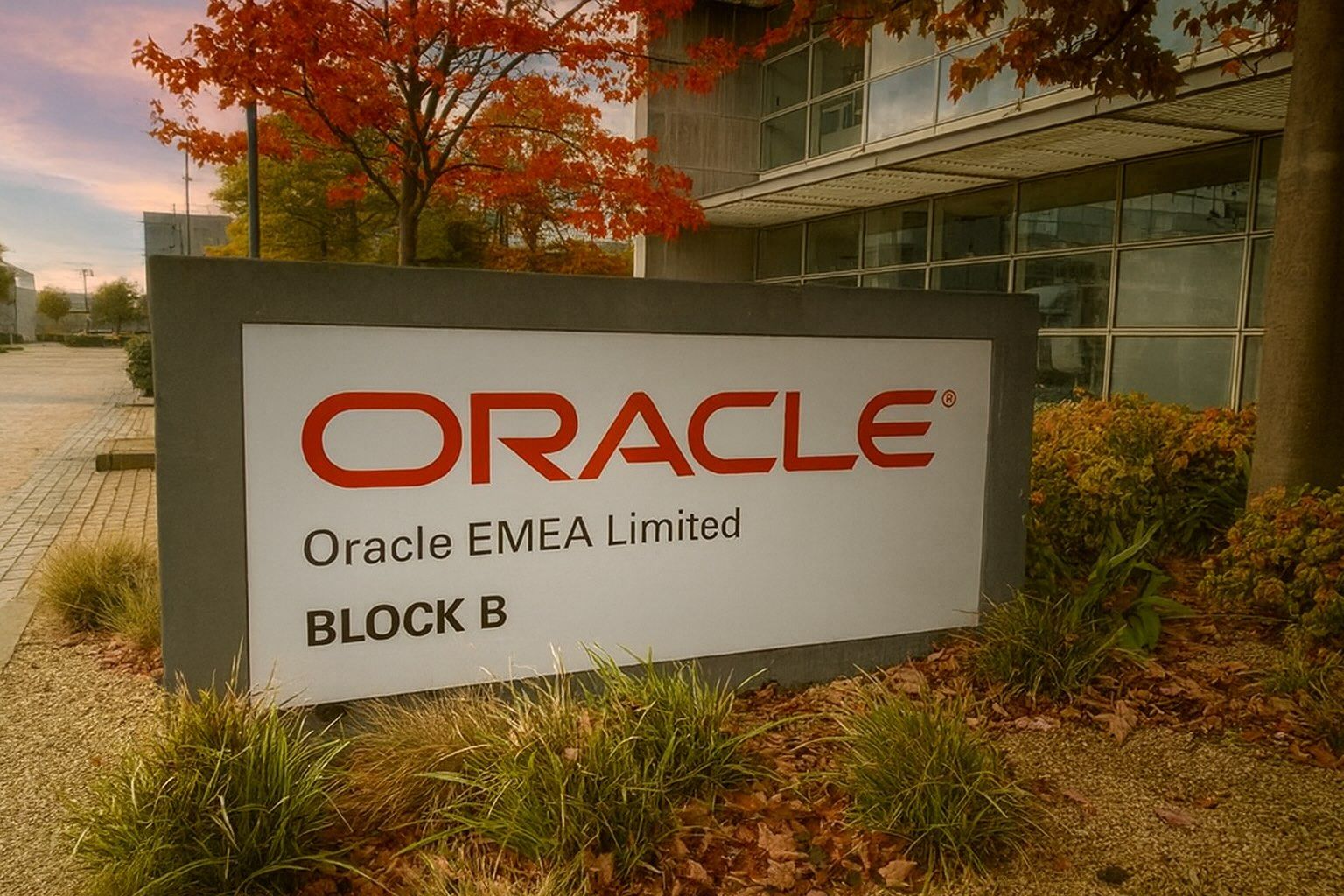- Current Stock Price & YTD Performance: Oracle (NYSE: ORCL) trades around $258 per share as of early November 2025, up roughly 50% year-to-date [1]. It dramatically outperformed the S&P 500 (up ~18% in the past year [2]) on the back of robust cloud and AI momentum. The stock hit a 52-week high of about $345.72 during mid-2025 [3] after an AI-driven rally, before pulling back to current levels.
- Market Capitalization: Oracle’s market cap hovers near $750 billion [4], cementing its status among the largest tech companies. It remains smaller than cloud rivals Microsoft (~$3.8 trillion) and Amazon, but larger than enterprise peers like SAP (~$317B) and Salesforce (~$250B). (See comparison table below.)
- Major 2025 Developments: Oracle’s cloud business surged with high-profile AI deals. Remaining performance obligations (backlog) rocketed to $455 billion in Q1 FY2026 (up 359% YoY) after Oracle signed multi-billion-dollar cloud contracts with a “who’s who of AI,” including OpenAI, Meta, Nvidia, and others. One landmark agreement – reportedly a partnership with OpenAI – is expected to generate $30 billion in annual revenue by FY2028 [5]. To meet soaring demand, Oracle boosted its FY2026 capital expenditure budget to $35 billion (adding $10B more than initially planned) to expand data center capacity.
- Sector Trends: Oracle is riding powerful tailwinds in cloud computing and artificial intelligence. Enterprise spending on AI-centric cloud infrastructure is exploding – global AI infrastructure spend is projected to jump from $60B in 2024 to $230B in 2026 [6]. Overall IT investment remains strong despite macro concerns; Gartner forecasts ~9–10% growth in worldwide IT spending in 2025 (to ~$5.6 trillion) [7]. Oracle’s focus on data security and “sovereign cloud” offerings aligns with trends of companies seeking private or hybrid clouds for regulatory and privacy reasons. Meanwhile, the cloud war continues as giants like AWS, Microsoft Azure, and Google Cloud invest unprecedented sums (>$80–100B annually) in infrastructure. Oracle’s challenge – and opportunity – is to carve out a growing niche in this AI-driven cloud surge.
ORCL Stock Price & Recent Performance
Oracle’s stock has been on a tear in 2025, propelled by accelerating cloud growth and AI enthusiasm. Shares started the year around the $170 level, then climbed steadily and spiked after mid-year earnings. By July, ORCL hit record highs near $240 (up 43% for 2025 at that point) [8], prompting analyst upgrades. Jefferies, for example, raised its price target to $270 in July, citing Oracle’s pivotal cloud deals and declaring the company at a “pivotal moment” in its evolution [9] [10]. The rally peaked in September when Oracle briefly traded above $300.
However, after touching its 52-week high (~$345) [11], the stock saw some profit-taking. A broader late-September tech selloff and valuation concerns cooled the stock back down to the mid-$200s. Even so, at ~$258 today, Oracle remains up roughly 50% year-to-date [12] – a stellar performance reflecting investor optimism in its cloud trajectory and AI positioning. For context, Microsoft is up about 22% YTD [13], Salesforce ~–20% (after a big 2023 run) [14], and SAP about +5% [15], making Oracle one of 2025’s enterprise software standouts.
Short-term trend: In recent weeks, ORCL has been consolidating in the $250–$270 range. The stock’s 50-day moving average sits around $278 [16] (above the current price, indicating recent downward momentum), while the 200-day average near $206 suggests the longer-term uptrend is still intact. Technical trading has identified support around the mid-$250s (recent lows ~$255) and near $250 – a level that coincides with Oracle’s summer breakout and could act as a floor. Resistance is visible around $265–$270 (recent highs) and more strongly at the psychological $300 level, which ORCL would need to clear to regain its previous highs.
Analyst Forecasts and Expert Commentary
Wall Street sentiment on Oracle is broadly positive. The consensus analyst rating is a “Moderate Buy,” with many highlighting Oracle’s cloud momentum. As of Q4 2025, 28 out of 40 analysts tracked lean bullish (Buy) on ORCL. The average 12-month price target sits in the mid-$250s per share – roughly in line with the current price – reflecting that the stock’s big 2025 run has caught up to earlier forecasts. Targets, however, vary widely: some bulls see Oracle climbing to $300–$325, while cautious analysts see fair value closer to $200. According to TipRanks data, recent price targets span from a low of $195 to a Street-high of $400, underscoring differing views on how successfully Oracle can execute its ambitious cloud plans.
Notable commentary: Guggenheim’s John DiFucci in June raised ORCL’s target from $220 to $250, calling Oracle a potential “decade stock” poised for a “narrative shift” thanks to AI and cloud growth [17]. He argues the market is beginning to re-rate Oracle after “decades of [being seen as] a legacy database provider” – now recognizing it as a bona fide cloud player [18] [19]. Jefferies became a top bull this summer, hiking its target to $270 and pointing to Oracle’s $30B/year cloud contract (implied OpenAI deal) as transformative [20] [21]. Stifel likewise lifted its target to $250 (from $180) after Oracle’s strong cloud growth in Q4 FY25 [22]. More recently, in August, TD Cowen went further – raising its target to $275 and maintaining an Outperform rating, as Oracle’s AI investments and backlog surge bolstered confidence in sustained growth. A few ultra-bullish analysts (e.g. at Mizuho and Cowen) even suggested upside to $300+ if Oracle’s cloud ramp accelerates, as it did mid-year.
That said, some analysts urge caution. Oracle’s stock isn’t cheap after this rally – trading around 40× earnings (forward P/E in the mid-30s) which is above its historical range [23]. Bears point to execution risks: Oracle must manage massive capital spending and integration of big contracts without eroding margins. For instance, S&P Global affirmed Oracle’s BBB credit rating but revised the outlook to negative, citing that Oracle’s aggressive cloud build-out is straining free cash flow and leveraging its balance sheet [24] [25]. S&P warned that if Oracle’s debt/EBITDA stays above ~3.5× due to heavy CapEx and relatively weak near-term cash flow, a credit downgrade is possible [26]. In short, the bull thesis is that Oracle’s bold cloud+AI bets will pay off in explosive growth (justifying the high spending), whereas skeptics worry about the financial strain and competition during that ramp-up.
On balance, expert sentiment leans optimistic about Oracle’s 2025–2026 trajectory, but with an eye on execution. Look for analysts to update forecasts after each earnings report – especially Oracle’s FY2026 Q2 results (due in December) – to gauge if cloud growth and bookings remain on track with Oracle’s lofty guidance.
Fundamental Analysis: Revenue, Earnings, and Cash Flow
Revenue Growth: Oracle’s fundamentals in 2025 show a company successfully transitioning to the cloud. In the fiscal year 2025 (ended May), Oracle’s revenue was $57.4 billion, up 8% YoY [27] [28]. This growth accelerated into FY2026. In the latest quarter (Q1 FY26, quarter ended Aug. 2025), total revenues jumped 12% YoY to $14.9B. Crucially, cloud services are now the main growth engine: Q1 cloud revenue (IaaS + SaaS) hit $7.2 billion, soaring 28% YoY. Within that, Oracle’s cloud infrastructure (OCI) revenue was $3.3B, up a remarkable 55% YoY – evidence of booming demand for Oracle’s cloud capacity. Cloud applications (SaaS) revenue grew 11% YoY to $3.8B, with solid gains in its Fusion and NetSuite cloud ERP suites (both ~16–17% growth). Meanwhile, Oracle’s traditional on-prem software license business is flat to declining (software license revenues actually dipped ~1% in Q1), highlighting the shift toward cloud subscriptions.
Profitability & Margins: Despite heavy investment, Oracle remains highly profitable. In Q1 FY26, Oracle delivered a GAAP operating income of $4.3B and non-GAAP op income of $6.2B – indicating an operating margin around 41% (non-GAAP) on $14.9B revenue. GAAP net income for the quarter was $2.9B, which is a ~19% net margin; on a non-GAAP basis net income was $4.3B (29% margin). These margins, while strong, are a tad lower than Oracle’s historical norm due to the surge in expenses (chiefly data center costs and depreciation from new equipment). Oracle’s trailing-12-month GAAP EPS is about $4.34 (FY25) [29], and non-GAAP EPS ~$6.03 [30]. The company continues to return cash to shareholders even as it invests – Oracle pays a quarterly dividend of $0.50 (about 0.8% yield), and has done modest share buybacks in recent years.
However, cash flow is a watch item. Over the past 12 months, Oracle’s operating cash flow was $21.5B – up 13% – but capital expenditures in FY2025 spiked to $21.2B (triple the prior year) [31], largely for building out cloud infrastructure. This resulted in only a slight positive free cash flow. S&P noted Oracle’s FY25 CapEx was ~37% of revenue (vs 17% two years prior) and projects FY26 CapEx could reach 40% of revenue [32] [33]. Indeed, Oracle management itself signaled FY26 CapEx around $35B (vs ~$21B in FY25), meaning free cash flow may remain near breakeven through 2026. Oracle has taken on debt to support these investments – its long-term debt stands around $94B (net debt lower after cash). Credit agencies are watching leverage carefully; Fitch expects Oracle to use some debt to fund CapEx but still affirms a BBB rating (stable outlook) provided growth materializes [34]. The bottom line is that Oracle’s earnings quality is solid (non-GAAP EPS still growing ~6% YoY), but free cash flow is temporarily depressed by upfront cloud spending.
Guidance & Outlook: Oracle’s executives are extremely bullish on future growth, given the unprecedented backlog of cloud orders. CEO Safra Catz highlighted that Oracle signed four multi-billion-dollar cloud contracts in Q1 alone, driving RPO (remaining performance obligations) to $455B. She expects to sign “several additional” big customers soon, pushing RPO above $500B. Consequently, Oracle made a major upward revision to its medium-term plan: OCI (cloud infra) revenue is now forecast to reach $18B in FY2026 (77% growth YoY), and then expand to $32B, $73B, $114B, and $144B over the subsequent four fiscal years. Those figures, if achieved, imply Oracle’s cloud business would grow nearly 10× in five years – an aggressive trajectory. Most of that growth “is already booked in our reported RPO,” Catz noted.
While such forecasts should be taken with a grain of salt, they indicate management’s confidence. Oracle’s near-term guidance (given in June) was for total cloud growth >40% in FY26 (vs 24% in FY25) and OCI infrastructure growth >70% [35]. So far, Q1 delivered 54% OCI growth, and Q2 (to be reported in Dec) will be closely watched to see if that acceleration continues or if any constraints (supply chain or customer ramp-up delays) emerge. Bottom line: Oracle’s fundamentals show a legacy tech giant successfully reinventing itself for the cloud era – revenue mix shifting to cloud subscriptions, healthy (if slightly pressured) margins, and huge forward demand. Investors will monitor whether Oracle can convert its $455B backlog into revenue on schedule without major cost overruns.
Technical Analysis: Chart Trends & Indicators
From a technical standpoint, Oracle’s chart reflects its big run-up and recent consolidation:
- Moving Averages: ORCL is trading below its 50-day moving average (~$278) [36] – a sign of short-term weakness since the post-summer pullback. However, it remains well above the 200-day MA (~$206) [37], so the long-term uptrend (established in 2023–2024) is intact. The gap between the 50-day and 200-day has narrowed as the stock cooled; a bearish crossover isn’t imminent yet, but traders are watching if momentum doesn’t improve.
- Relative Strength Index (RSI): Oracle’s 14-day RSI is currently in the low-40s [38], which is in the neutral to slightly oversold range. For context, during its September peak the RSI had crept above 70 (overbought territory), so the recent decline relieved that overheated condition. An RSI around 40 suggests there’s room for the stock to rally before hitting overbought levels again, assuming buyers return.
- MACD & Momentum: The Moving Average Convergence Divergence indicator for ORCL has turned negative (MACD ≈ –4.3), reflecting the loss of upward momentum after the peak [39]. Some technical models actually view the current MACD setup as a potential buy signal [40] (on the premise that negative momentum may be bottoming out). The ADX (trend strength) is relatively low (~15) [41], implying the recent downtrend is not especially strong – more of a trading range market than a decisive fall.
- Support & Resistance: Immediate support lies around $255–$260 (the lows of late October/early November). Notably, $255 was the intraday low on Nov 3, and technical analysts identified ~$255.23 as key support in the short term. If that level fails, the next major support zone is around $225–$230 (coinciding with Oracle’s August 2025 lows around $226 and a prior breakout point). On the upside, $265–$270 is the first resistance region – recent attempts to rally stalled in that zone. Above that, the $300 level is a significant psychological and technical resistance; it marks where Oracle broke down in October and would likely be a selling zone unless very strong catalysts emerge. Finally, the all-time high near $345 is the ultimate resistance – a level not expected to be retested absent exceptional news.
In summary, Oracle’s technical picture in late 2025 shows a stock digesting huge gains. The bias is neutral in the short term – neither overbought nor deeply oversold. A break below ~$250 support could signal further downside risk (toward the low $200s), whereas a push back above the 50-day MA (>$278) and $300 would indicate bulls regaining control. Traders are watching volume trends as well: after the early-Sept euphoria, volume has normalized, indicating no panic selling – rather a pause as investors await the next catalyst (like earnings or macro news).
Oracle’s Position in AI, Cloud, and Database Markets
Oracle has long been synonymous with database software, but in 2025 its identity is equally tied to cloud infrastructure and AI. Here’s how Oracle is positioned in its key sectors:
- Cloud Computing (OCI): Oracle Cloud Infrastructure (OCI) is emerging as a “junior hyperscaler” in a market dominated by Amazon AWS, Microsoft Azure, and Google Cloud. Oracle knows it cannot outspend those giants, so it’s pursuing a differentiated strategy: targeting AI workloads, emphasizing enterprise-grade security, and leveraging partnerships. In 2025, Oracle made bold moves by partnering with top chipmakers Nvidia and AMD to supercharge OCI for AI. In October 2025, Oracle announced it will deploy 50,000 of AMD’s latest MI450 GPUs in OCI and unveiled “OCI Zettascale10” – a new supercluster connecting Nvidia GPUs across data centers to create “the largest supercomputer in the cloud”. This infrastructure underpins a landmark collaboration with OpenAI (codenamed “Stargate”), where Oracle provides massive capacity (4.5 GW of data center power) to OpenAI in exchange for long-term cloud commitments. Such deals catapulted Oracle’s cloud backlog. Analyst Tracy Woo at Forrester noted OCI is “playing both sides” by partnering deeply with Nvidia and AMD, unlike rivals who develop in-house chips – giving Oracle access to more GPU supply. The upshot: Oracle is carving a niche as the go-to cloud for AI model training and inference. Chairman Larry Ellison stresses that AI inference (deploying models in production) will “be much larger than the AI training market” – and Oracle is positioning OCI to excel in inference by being the “world’s largest custodian of enterprise data” that AI can tap.
- Artificial Intelligence Services: Oracle is embedding AI across its product stack. For instance, in database (see below) and in its enterprise apps (Fusion AI features). At Oracle AI World 2025 (held in October), the company announced an “Oracle AI Database” service. This novel offering lets customers bring advanced large language models (LLMs) – e.g. OpenAI’s GPT-4, Google’s Gemini, or even emerging models like xAI’s Grok – directly into the Oracle Database. Essentially, it enables AI to analyze data stored in Oracle databases with minimal friction, unlocking insights from corporate data using natural language. Ellison touted this as revolutionary, allowing tens of thousands of Oracle DB customers to “instantly unlock the value” in their data via AI. Oracle is also leveraging generative AI in its business applications (e.g. AI-assisted financial reporting in ERP, intelligent sales predictions in its CRM tools). By integrating AI models as a cloud service, Oracle not only drives OCI consumption but also adds value to its SaaS offerings. Additionally, Oracle’s partnership with Nvidia extends beyond hardware into software – they integrated Nvidia’s AI software stack with OCI, making it easier for developers to train and deploy AI on Oracle Cloud. With these moves, Oracle is ensuring it isn’t left behind in the AI wave; rather, it’s seeking to be an AI enabler for enterprises, competing with the likes of Azure’s OpenAI services and AWS’s AI platforms.
- Database Services (On-Prem & Multi-Cloud): Oracle’s core franchise – the Oracle Database – remains critical, but the strategy has evolved. Recognizing many enterprises use multiple clouds, Oracle made the Oracle Database available on rival clouds via a multi-cloud partnership model. In 2023–2025, Oracle struck deals with Microsoft, Amazon, and Google to install Oracle Exadata database hardware inside their data centers. By Q1 FY26, this Oracle Database@Azure/AWS/GCP service was live in 34 regions (up from 23 the prior quarter) [42], with 37 more deployments planned [43]. The result: Oracle’s “distributed cloud” database revenue (managed by others’ clouds) skyrocketed 1,529% YoY in Q1. This is a smart play – instead of fighting the multi-cloud trend, Oracle is monetizing it. Microsoft even deepened its alliance with Oracle in 2023 by offering “Oracle Database@Azure” as a native service for Azure customers, acknowledging many large enterprises run Oracle DB. These partnerships broaden Oracle DB’s reach and generate new high-margin revenue streams (Oracle charges for the DB licenses/services while the partner provides infrastructure). Additionally, Oracle continues to sell Cloud@Customer deployments – essentially delivering a full Oracle Cloud region on-premises for a client. Ellison revealed Oracle can set up a private Oracle Cloud region for about $6 million for customers who want isolated, single-tenant clouds. This appeals to banks, governments, and others with data sovereignty concerns. In sum, Oracle’s database strategy is now “Any Cloud, Any How” – letting customers run Oracle databases in Oracle’s cloud, in other clouds, or on-prem private clouds. This flexibility protects Oracle’s dominant database market share against encroachment from cloud-native databases.
- Enterprise Applications (ERP, CRM, etc.): While the spotlight is on cloud infra, Oracle’s SaaS business is also significant. Oracle Fusion Cloud ERP and HCM continue to gain large customers (often at the expense of legacy SAP ECC or Workday in some cases). In Q1, Fusion ERP revenue grew 17% and NetSuite ERP 16% – healthy for mature products. Oracle has positioned itself strongly in ERP (enterprise resource planning) software, especially for big enterprises (Fusion) and mid-size firms (NetSuite). In CRM and marketing, Oracle is less dominant (Salesforce leads in pure-play CRM), but Oracle’s integrated suite (database + middleware + apps) can be attractive for companies looking to consolidate vendors. Oracle’s recent Cerner acquisition also makes it a player in healthcare IT (electronic health records via Oracle Health). While not a focus of this stock forecast, it’s worth noting Oracle is leveraging AI in these apps too (e.g. using AI to automate financial close processes or patient data analysis). These “steady” software businesses provide recurring revenue that helps fund Oracle’s cloud ambitions.
Overall, Oracle’s strategic positioning in 2025 can be summarized as: Aggressively all-in on cloud and AI, while leveraging its legacy strengths (database technology and enterprise relationships) to differentiate. Oracle is no longer just a database company – it’s now competing in the cloud infrastructure big leagues, using unique tactics (e.g. massive AI deals, multi-cloud partnerships, private cloud offerings) to punch above its weight. If Oracle executes well, it could become a major beneficiary of the AI revolution, bridging the gap between cutting-edge AI and the troves of enterprise data it already manages.
Competitive Landscape: Oracle vs Microsoft, SAP, Salesforce
Oracle’s competitors span multiple categories – cloud infrastructure, enterprise software, and database – so let’s compare Oracle with a few key rivals:
1. Microsoft (Azure, SQL Server, Dynamics) – Competitive dynamic: Microsoft is both a partner and a competitor to Oracle. On cloud, Microsoft Azure is second only to AWS in market share and is far larger than OCI. However, Microsoft and Oracle recently forged a partnership to interconnect their clouds and even to host Oracle services on Azure (acknowledging many enterprises use both). Microsoft’s strengths include a massive customer base, integrated offerings (Azure + Office 365 + Dynamics apps), and an aggressive AI push (via its OpenAI partnership). Oracle competes by offering specialized performance (OCI is optimized for Oracle software and certain AI tasks) and flexibility. In databases, Microsoft’s SQL Server and Azure database services compete with Oracle Database for certain workloads, particularly mid-market. Microsoft’s cloud revenue (~$92B in 2025) dwarfs Oracle’s ($24.5B in cloud FY25) [44], but Oracle’s cloud is growing faster in percentage terms. In stock terms, MSFT has a considerably higher valuation (market cap ~$3.8 trillion) and a more diversified business (Windows, gaming, etc.). Oracle can’t match Microsoft’s breadth, but it is focusing on depth in enterprise infrastructure. Both stocks have been 2025 winners, though Oracle (+50% YTD) outpaced Microsoft (~+22% YTD) [45] thanks to its smaller base and more dramatic surprise in cloud growth.
2. SAP SE – Competitive dynamic: SAP, based in Germany, is the other giant of enterprise software (especially in ERP). Oracle and SAP have a long rivalry: Oracle’s database underpins many SAP systems, yet SAP has its HANA database and a broad ERP suite that competes with Oracle Fusion. In recent years, Oracle’s cloud ERP has been gaining market share, while SAP has been slower to transition its huge installed base of on-premise ERP customers to its cloud S/4HANA product. SAP remains strong in Europe and manufacturing industries, whereas Oracle’s cloud apps gained traction in North America and services sectors. Financially, SAP’s growth has been more modest – single digits – and it is a smaller company by market cap (~$300B). SAP’s stock had a stellar 2024 but has been flat in 2025 (up only ~5% YTD) [46], suggesting investors see it as a stable, slower-growth play. Oracle, with its higher growth rate and cloud narrative, has been rewarded with a richer valuation. One area to watch: SAP is also investing in AI (often via partnerships with companies like Microsoft and IBM) to enhance its applications; Oracle’s deeper integration of AI into its database and cloud may give it an edge in performance for certain workloads. However, SAP’s entrenched customer relationships (especially in core ERP for large multinationals) mean Oracle can’t be complacent. The two will likely continue to compete for digital transformation projects, with Oracle pitching its unified cloud stack and SAP emphasizing its business process expertise.
3. Salesforce, Inc. – Competitive dynamic: Salesforce (CRM) is the leader in cloud CRM and a pioneer of SaaS. It doesn’t directly compete in cloud infrastructure (it runs on its own platform, not offering general IaaS), but it’s a rival on business applications and platform. Oracle’s CRM offerings (Oracle CX Cloud) have a much smaller market share compared to Salesforce Sales Cloud. Nonetheless, Oracle’s strategy has been to offer a full suite (ERP, HCM, CRM, etc.) on a common cloud, which can appeal to clients tired of integrating many point solutions. Salesforce in 2025 is focusing on margin improvement and AI features within its platform (like Einstein GPT). Notably, Oracle’s founder Larry Ellison and Salesforce’s CEO Marc Benioff have a famous love-hate relationship (Benioff is an ex-Oracle exec). At times Oracle and Salesforce partner (Oracle’s database underpins Salesforce’s service, and they’ve had deals to use each other’s tech), but largely they compete in the enterprise SaaS arena. Stock-wise, CRM had a huge run in 2023 (+98%) [47], but has underperformed in 2025 (roughly flat to down) as growth slowed and the stock digested gains. Oracle has handily outperformed Salesforce this year, as investors rotated into infrastructure plays (AI-exposed) from pure SaaS. Going forward, if enterprise software spending tightens, Salesforce could feel it in slower sales cycles, whereas Oracle’s large backlog gives it some revenue visibility. Oracle also enjoys a broader product portfolio (including database and hardware), whereas Salesforce is more of a pure-play software vendor. In summary, Oracle competes with Salesforce on some fronts (customer experience apps) but also partners via back-end technology; both are pushing AI as a value-add for customers.
To summarize competitively, Oracle holds its own in a tough field by leveraging what it’s best at – databases, integrated systems, and now cloud infrastructure optimized for enterprises. Microsoft remains a formidable competitor in cloud and is arguably ahead in AI integration (with OpenAI’s models on Azure), yet Oracle has surprised many by grabbing marquee AI workloads. SAP and Salesforce are more focused on applications; Oracle competes by bundling apps with infrastructure (for example, an Oracle ERP customer might be enticed to also move their workloads to OCI). Oracle’s ability to maintain alliances (with MSFT, NVIDIA, even potential with IBM or others) while competing is a delicate balance that thus far has expanded its TAM (total addressable market). The table below highlights some key metrics comparing Oracle with these peers:
| Metric (2025) | Oracle (ORCL) | Microsoft (MSFT) | SAP SE (SAP) | Salesforce (CRM) |
|---|---|---|---|---|
| Market Cap (USD) | ~$750 B [48] | ~$3.8 T [49] [50] | ~$317 B [51] | ~$250 B (approx) |
| 2025 YTD Stock Return | + ~50% [52] | + ~22% [53] | + ~5% [54] | ~–20% [55] |
| FY2025 Revenue Growth (YoY) | +8.4% [56] | +~15% [57] (est.) | +~2% (est.) | +8.7% [58] |
| Cloud Revenue (latest FY) | $24.5B (+24%) [59] | ~$110B (+20%) | ~$5B (+24%) | N/A (SaaS only) |
Sources: Company reports and analyst estimates; Cloud revenue for Microsoft is Intelligent Cloud segment FY25, for SAP is Cloud segment 2024. Oracle and SAP growth in constant currency where noted.
As shown, Oracle’s growth and stock performance outpaced the more mature peers in 2025. It is closing the gap in cloud (though still far behind in absolute revenue). The competitive landscape will continue to evolve – notably, Google Cloud and Amazon Web Services (AWS), though not tabled above, are also direct competitors to OCI. AWS remains the #1 cloud provider globally, and Oracle often finds itself competing with AWS for deals (Oracle won some high-profile ones like the CIA cloud contract alongside others). The macroeconomic environment and customer preferences (best-of-breed vs one-stop-shop) will influence how much share Oracle can win from these giants.
Macroeconomic & Regulatory Factors
Broader forces in the economy and policy arena also impact Oracle’s stock:
- Interest Rates & Valuation: 2025 saw persistently high interest rates as central banks fought inflation. Higher rates generally pressure tech stock valuations (future earnings discounted more), and companies with high capital needs feel a squeeze. Oracle’s heavy CapEx program has been financed in part by debt – indeed, it issued ~$15B in bonds in 2025, adding to its debt load [60]. Rising interest expenses or tighter credit could weigh on its margins. However, if inflation continues to cool and the Federal Reserve pivots to rate cuts in 2025–2026, it could relieve some valuation pressure on growth stocks like Oracle. Lower rates would also make Oracle’s dividend and earnings more attractive in relative terms. Thus, macro interest rate trends are a double-edged sword: they’ve made Oracle’s aggressive spending riskier, but any easing could provide a tailwind for its stock multiples.
- Global Tech Demand: Despite recession fears in early 2025, enterprise tech spending has proven resilient. Gartner projects nearly 8–10% growth in global IT spending in 2025 [61], with particular strength in software and cloud services. This secular demand for digital transformation and cloud migration benefits Oracle. That said, if a broad economic downturn hits (e.g. a hard landing scenario), corporations might slow their cloud migrations or trim IT budgets, which could moderate Oracle’s growth. So far, however, Oracle’s large backlog insulates it somewhat – many customers have signed multi-year cloud commitments. The mix of customers (AI firms, government, large enterprises) also matters: Oracle’s recent wins like OpenAI, Meta, and government deals may be less sensitive to short-term economic swings (AI firms are backed by huge capital, governments have set budgets). Moreover, cloud services can even be a cost-saver for companies, which might actually accelerate cloud adoption in a downturn to save money long-term. Oracle’s management noted that cloud demand “continues to dramatically outstrip supply” in their case, implying a structural trend rather than cyclical.
- Regulatory Environment: Oracle isn’t in the crosshairs of regulators the way consumer tech giants are, but broader tech regulation could still affect it. Two areas to watch: antitrust and AI regulation. On antitrust, Oracle’s market power in databases has occasionally drawn scrutiny (in past decades), but currently cloud competition is fierce so it’s not monopolistic there. If anything, Oracle has positioned itself as an alternative to the “Big Three” clouds, even lobbying governments that too much enterprise data is concentrated in Amazon/Microsoft/Google. Oracle’s past role in high-profile cases (it supported the DOJ’s case against Google’s search monopoly, for instance) shows it often plays the regulatory angle to its advantage. As for AI regulation, governments are moving to set rules on AI usage, data privacy, and possibly requiring disclosures on AI models. Oracle, being an infrastructure provider, might benefit if stricter rules push companies to trusted, secure clouds (Oracle touts its security and compliance). However, regulations that, say, limit AI training or require expensive safeguards could slow AI deployment industry-wide, potentially reducing short-term demand for AI cloud capacity. Oracle’s emphasis on data security and offering private cloud options could actually align well with a stricter regulatory environment (companies might choose Oracle to keep sensitive data in a dedicated cloud). Additionally, any export controls or trade tensions (e.g. US-China tech war) could indirectly affect Oracle: it relies on advanced chips from Nvidia/AMD – restrictions on chip supply or Chinese retaliation could impact costs or demand. Oracle has a global business, but its China presence is relatively small compared to others, so it’s less exposed to that market’s turmoil.
- Currency and Inflation: Oracle reports in USD, so a strong dollar can be a headwind (makes overseas sales translate to fewer dollars). In FY25, Oracle faced some currency headwinds (constant currency growth was 1% point higher than USD growth). If the dollar weakens in 2025–26 as some expect (if US rates peak), Oracle could see a modest forex boost. On inflation, Oracle’s costs (like energy for data centers, wages for tech talent) are subject to inflationary pressure. The company has indicated cloud infrastructure costs are rising (hence the CapEx increase). Any easing of hardware supply chain inflation (e.g. memory chips, construction costs) would help Oracle’s margins on cloud. Oracle has pricing power to an extent – for mission-critical software, customers are somewhat price-insensitive – but cloud pricing is competitive, so Oracle can’t simply jack up prices without risking competitiveness.
In summary, macro factors present a mixed backdrop: interest rates and debt load are a concern, but robust IT spending and potential rate cuts could favor Oracle. The regulatory climate may actually open opportunities for Oracle as a “safe” enterprise cloud, though global geopolitical risks around tech remain something to monitor. Investors should keep an eye on central bank moves, enterprise confidence surveys, and any major policy changes around AI and cloud as we approach 2026.
Oracle Stock Forecast Scenarios (End of 2025)
With just under two months left in 2025, Oracle’s year-end price will depend on upcoming earnings and any macro swings. We outline three scenarios – Bullish, Base Case, and Bearish – for ORCL stock by the end of 2025, along with the rationale:
Bullish Scenario (~$300+ by Dec 31, 2025)
In a bullish scenario, Oracle’s stock rallies back toward its highs, reaching the $300 level or above by year-end. This would require a combination of positive factors, such as:
- Blowout Earnings: Oracle’s Q2 FY26 results (expected in mid-December) beat expectations, showing reaccelerating cloud growth and perhaps announcing additional big cloud customer wins. If Oracle reports, say, >13% total revenue growth with OCI growth still 50%+ and raises guidance, it would reignite investor enthusiasm. Any news of new multi-billion cloud deals (similar to the OpenAI deal) could be a catalyst.
- AI Hype & Fed Tailwind: Broad tech market conditions turn favorable – perhaps the Federal Reserve hints at rate cuts sooner than expected, lifting all tech stocks. AI-related stocks could get another boost if, for example, OpenAI or Meta share usage metrics that imply surging cloud consumption (and thus revenue for Oracle). Nvidia’s CEO recently expressed confidence that Oracle will be “wonderfully profitable” from AI demand – a narrative like that catching on could drive bullish sentiment.
- Multiple Expansion: In this optimism, investors might be willing to pay a richer multiple for Oracle’s growth. If Oracle demonstrates it can sustain 15%+ revenue growth into 2026 (well above historical single-digits), the market might re-rate it closer to a high-growth cloud peer. A year-end forward P/E of ~40 on anticipated FY26 EPS could justify a ~$300 stock price.
Rationale: In this bull case, Oracle’s AI/cloud story proves its worth quickly – essentially showing that the huge backlog will convert to revenue faster and more profitably than skeptics thought. With improving macro sentiment (lower rates) and perhaps a seasonal rally, ORCL could close 2025 near all-time highs. The bullish scenario also assumes no major negative surprises – supply of chips is ample, no slowdowns in client AI projects, etc. This scenario would also likely coincide with the broader Nasdaq rising into year-end.
Base Case Scenario (~$260–$275)
The base case envisions Oracle stock ending 2025 roughly around current levels or modestly higher, say in the mid to upper-$200s (perhaps +5–10% from here). This assumes:
- Solid but Unspectacular Earnings: Oracle’s Q2 results are in line with forecasts. Cloud growth remains robust (e.g. ~40% OCI growth, good but decelerating a bit from Q1’s 54%), and management reiterates full-year targets without raising them. There are no big new deal announcements, but also no red flags. In other words, Oracle continues executing steadily.
- Neutral Macro: The macro environment remains stable – no new shock from interest rates or recession fears beyond what’s already baked in. Perhaps the Fed maintains current rates (no cut yet, but no hike either), so equity valuations hold steady. Broader tech stocks might be flat to slightly up, lacking a strong year-end rally but not selling off either.
- Range-bound Trading: In this scenario, Oracle stock likely continues to trade range-bound. It could drift up into the $260s or $270s if year-end window dressing by funds favors big-cap tech, but strong overhead resistance (around $300) isn’t tested without a bigger catalyst. The stock’s valuation in this base case stays around a forward P/E of ~35, which given Oracle’s ~$6.50-7.00 potential non-GAAP EPS for FY26, would put it roughly $230–$250; however, markets often price in growth beyond one year for such stories, so mid-$260s would imply confidence in FY27 growth too.
Rationale: The base case essentially says Oracle’s positives (cloud growth, backlog) and negatives (huge spending, competition) balance out in investors’ minds. The stock neither soars nor sinks dramatically. It’s a “wait-and-see” outcome: investors choose to monitor a few more quarters of execution. Oracle might finish 2025 as one of the year’s top large-cap performers, consolidating those gains rather than adding to them. Many analysts’ targets (which cluster around $250–$280) would align with this scenario, meaning the stock would be near fair value on Dec 31.
Bearish Scenario (~$210–$230)
In a bearish scenario, Oracle could retreat further, potentially ending 2025 down in the low $200s. This could happen if:
- Disappointment or Delay: Suppose Oracle’s Q2 earnings or guidance disappoint the market. For instance, if cloud growth comes in below expectations (say OCI growth dips under 40% or signs of slower cloud bookings emerge), investors might fear that the AI backlog ramp is not as fast as promised. Or if Oracle were to warn that FY26 CapEx will be even higher (signaling maybe deployment challenges), that could spook investors about cash flow.
- Macroeconomic/Market Pullback: If late 2025 brings a broad market sell-off – perhaps due to renewed inflation worries, geopolitical tension, or a significant risk-off event – high-valuation stocks like Oracle could see sharper declines. A resurgence of bond yields or a shock jobs report could rotate money out of tech. In such a scenario, Oracle’s 50% YTD gain makes it a candidate for profit-taking.
- Competitive or Regulatory Issues: Another risk is if one of Oracle’s big competitors makes a surprising move that hurts Oracle’s narrative. For instance, if Microsoft or Amazon secures a huge AI cloud deal that Oracle was rumored to get, or if an OpenAI-type customer scales back plans. Additionally, any regulatory hiccup – e.g., if governments delay AI projects or impose rules slowing cloud adoption – could dampen enthusiasm. While less likely short-term, these could contribute to a bearish tone.
Under the bear case, ORCL might break key support levels (like $250). Technically, a slide toward the 200-day MA (around $206) could occur. That level also roughly corresponds to Oracle’s price just before the AI euphoria of mid-2025 – essentially giving back the AI premium. Oracle’s valuation in this scenario might compress to a forward P/E in the mid-20s, more in line with traditional software companies, if growth optimism wanes.
Rationale: In the bearish outcome, investors re-focus on risks – Oracle’s high spending, the fact that much of its AI revenue is still a couple years out (e.g. that $30B/year OpenAI revenue starts FY2028 [62], not immediate), and the reality that it faces formidable rivals. If the economic backdrop worsened, companies might delay migrating workloads (affecting Oracle’s shorter-term cloud consumption revenue). The bear scenario could also simply be a healthy correction after an overextended rally – Oracle did double from late 2022 to 2025, so some retracement isn’t implausible, especially if the broader market struggles.
Which scenario is most likely? The base case often tends to be the default – Oracle is likely to finish strong but perhaps not dramatically above its current price unless an extra catalyst arrives. Many analysts remain cautiously optimistic that Oracle will meet its growth targets (not wildly beat them), which aligns with a steady-as-she-goes stock performance. The bull case could materialize if the AI boom accelerates even faster or if interest rates drop, while the bear case would require a material negative surprise or market downturn.
Investors should watch the upcoming earnings and any news on cloud contract wins or expansions. Oracle’s guidance and capex commentary in the December call will be key – if Catz and Ellison strike an even more bullish tone and show evidence of demand, bulls may get the upper hand. Conversely, any hint of execution challenges could give bears ammunition.
Conclusion
Oracle’s 2025 story has been one of remarkable transformation – from a legacy enterprise software vendor into a rising force in cloud infrastructure and AI services. The stock’s performance – up about 50% this year – reflects newfound investor appreciation for Oracle’s growth trajectory in these booming sectors. Oracle has aligned itself with the biggest trend in tech (AI) and backed it with bold investments and big-name partnerships.
Going into 2026, Oracle stands at a crossroads: it has unprecedented demand on the horizon (a $455B backlog of cloud commitments), but also the herculean task of delivering that capacity and revenue on time and on budget. The stock forecast through end of 2025 and beyond will hinge on execution. Key signposts will be cloud revenue growth rates, operating margins vs. capex spend, and the competitive response from rivals.
For investors, Oracle offers a mix of growth and dividend stability, but at a richer valuation than in the past. Those bullish on enterprise AI and cloud adoption may view Oracle as a relatively undervalued AI play compared to more expensive names – especially if Oracle can achieve the kind of growth its executives project. Skeptics will note that Oracle’s journey is not without peril: integrating huge AI workloads is costly, and giants like Microsoft and AWS won’t cede ground easily.
In summary, our analysis suggests Oracle is well-positioned in the high-growth areas of cloud and AI, with strong fundamentals and improving street sentiment. The stock forecast tilts positive but acknowledges that much of 2025’s good news is already priced in. Barring a macro shock or execution stumble, Oracle is likely to finish 2025 around current levels or somewhat higher, with the real test coming in 2026 when we see how its massive investments translate into earnings. Investors should remain vigilant but optimistic as Oracle enters what could be one of the most significant chapters in its 46-year history – the quest to become a top-tier cloud powerhouse in the age of AI.
Sources: Oracle Investor Relations, CIO Dive, Investopedia [63] [64], S&P Global/Investing.com [65] [66], Gartner [67], Yahoo Finance/TipRanks [68], and others as cited throughout.
References
1. finance.yahoo.com, 2. finance.yahoo.com, 3. investor.oracle.com, 4. investor.oracle.com, 5. www.investopedia.com, 6. www.ciodive.com, 7. technologymagazine.com, 8. www.investopedia.com, 9. www.investopedia.com, 10. www.investopedia.com, 11. investor.oracle.com, 12. finance.yahoo.com, 13. ca.finance.yahoo.com, 14. totalrealreturns.com, 15. finance.yahoo.com, 16. finance.yahoo.com, 17. www.barchart.com, 18. www.barchart.com, 19. www.barchart.com, 20. www.investopedia.com, 21. www.investopedia.com, 22. www.investopedia.com, 23. www.barchart.com, 24. www.investing.com, 25. www.investing.com, 26. www.investing.com, 27. www.oracle.com, 28. www.oracle.com, 29. www.oracle.com, 30. www.oracle.com, 31. www.investing.com, 32. www.investing.com, 33. www.investing.com, 34. www.fitchratings.com, 35. www.oracle.com, 36. finance.yahoo.com, 37. ca.finance.yahoo.com, 38. www.tipranks.com, 39. www.tipranks.com, 40. www.tipranks.com, 41. www.tipranks.com, 42. www.ciodive.com, 43. www.ciodive.com, 44. www.investing.com, 45. ca.finance.yahoo.com, 46. finance.yahoo.com, 47. totalrealreturns.com, 48. investor.oracle.com, 49. finance.yahoo.com, 50. www.macrotrends.net, 51. finance.yahoo.com, 52. finance.yahoo.com, 53. ca.finance.yahoo.com, 54. finance.yahoo.com, 55. totalrealreturns.com, 56. www.oracle.com, 57. www.slickcharts.com, 58. stockanalysis.com, 59. www.investing.com, 60. www.ainvest.com, 61. technologymagazine.com, 62. www.investopedia.com, 63. www.investopedia.com, 64. www.investopedia.com, 65. www.investing.com, 66. www.investing.com, 67. technologymagazine.com, 68. finance.yahoo.com










